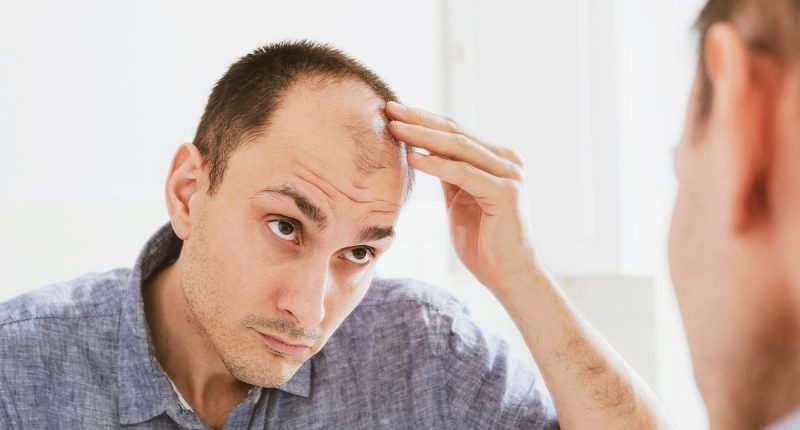Share this @internewscast.com
Spotting the first signs of baldness in the mirror can be a moment of true horror for many men.
Now, scientists in Spain think a cure for hair thinning could finally be just around the corner.
In a possible step towards curing baldness, experts at Hospital Clínico San Carlos in Madrid have grown hair on male and female mice using stem cells.
In lab experiments, some of the rodents’ coats were restored to full thickness in just three weeks.
What’s more, their anti-balding treatment could become available for people by 2029.
In the UK alone, it’s estimated that over 15.4million people – nearly a quarter of the population – suffer with hair loss.
There are already several treatment options available ranging from transplants to topical treatments, but these are either ineffective or costly.
‘In the future we will be able to offer new solutions that allow us to meet patients’ expectations,’ said lead study author Dr Eduardo López Bran, head of dermatology at Hospital Clínico San Carlos.

Scientists have developed a simple way to reverse hair loss – and say a treatment could be available before the end of this decade

After the mice were stripped of their fur, the chemical cocktail effectively reversed baldness in the majority of the rodents after 21 days
On the human scalp, the tens of thousands of strands of hair sit in tiny holes in the skin known as a hair follicles.
Usually, baldness occurs when the hair follicles shrinks over time due to genes and male sex hormones, resulting in shorter and finer hair.
Eventually, the follicle shrinks to the point that it does not grow new hair, which is why genetic, progressive hair loss from the scalp increases with age.
For decades, reconstructing skin with its associated structures like hair follicles and sebaceous glands has been a ‘major biomedical challenge’.
But the use of stem cells – special cells that have the ability to develop into many different cell types – offer a promising cure hair loss and hair thinning.
Stem cells have the potential to repair damaged tissues and even create new hair follicles by replicating younger ones.
For the study, the scientists gave male and female mice dihydrotestosterone (DHT), a hormone that plays a key role in the sexual development of males.
At the same time, DHT prevents nutrients from being absorbed by hair follicles, which causes them to shrink and fall out – resulting in hair loss.

3D illustration of hair cross section. Hair starts growing at the bottom of a hair follicle – the tunnel-shaped structure in the epidermis (the outer layer of the skin)

Microscopic images from the skin of male mice in the control (a) and experimental (b) treatment groups. The experimental group showed greater hair follicle density and bulb diameter
Once the mice had lost all their fur, half were injected with stem cells mixed with adenosine triphosphate (ATP), a compound that provides energy to cells.
‘The mix stimulates hair regeneration by combining the regenerative capacity of the former with the energy provided by the latter,’ said Dr López Bran.
‘This synergy favors the recovery of the hair follicle, promoting hair growth.’
The other half – the ‘control’ group of mice – were not given the chemical combination in order to act as a comparison.
For the first seven days, the hair regrowth in the injected mice was minimal, suggesting a similar therapy in humans could take over a week to take effect.
But after 21 days, all male mice treated with low doses experienced hair regrowth – half of them completely and the other half ‘intensively’.
Meanwhile, 90 per cent of female mice experienced hair regrowth after medium doses. Of these, 50 per cent achieved complete regrowth and 40 per cent ‘intensive’ regrowth.
Researchers also found that the experimental group had greater hair follicle density and bulb diameter, which can result in greater thickness of the hair strand and in turn stronger hair.

For the first seven days, the hair regrowth was minimal, suggesting a similar therapy in humans could take over a week to take effect

In the UK alone, it’s estimated that over 15.4million people suffer with hair loss. There are several treatment options available already – ranging from wigs to topical treatments. However, many of these are costly, and few are 100 per cent effective
Sadly, the mice were euthanized by exposure to deadly amounts of carbon dioxide at the end of the study.
But if the chemical cocktail could be cleared for use in humans, it could slow the progression of baldness or even reverse the initial symptoms.
Dr López Bran and colleagues estimate that this could be a reality four or five years from now, so maybe before the end of this decade.
But well before this, the next phase of testing will involve using human patients who have lost their hair or a showing hair loss signs.
Speaking to the Mail, Dr López Bran explained that the treatment would be administered via injections to the scalp.
‘This treatment is expected to be administered via mesotherapy to the scalp – that is, through an injection,’ he said.
‘As such, it would not be available for purchase in pharmacies, but would require administration by a specialised healthcare professional.’
The cost of the treatment remains unclear.

Dr Eduardo López Bran (pictured), head of dermatology at Hospital Clínico San Carlos, wanted to investigate the safety of a hair treatment based on the implantation of stem cells – first using mice
‘As for the cost, any economic estimate would be purely speculative at this stage and entirely dependent on how the efficacy and safety results progress,’ Dr López Bran added.
Although the results of this research are promising, the authors note that additional clinical trials will be needed to confirm its safety in humans.
While not life-saving research, the experts call hair loss a problem because it can affect ‘a sufferer’s self-esteem and quality of life’.
Currently, there are various treatments for hair loss, including drug therapies, lasers and follicular transplantations, although they are not without limitations.
The study, published in Stem Cell Research & Therapy, offer ‘a good therapeutic option’ for the use of stem cells in hair regrowth.
Similarly, Harvard University scientists have before now created skin organoids – tiny tissue cultures – from stem cells in a lab dish.
These can generate into multi-layered skin tissue with hair follicles, sebaceous glands and neural circuitry when cultured for four to five months.
Another method proposed recently by scientists in Japan involves the use of two plant extracts which both naturally aid growth – phellodendron bark (found in tropical parts of Asia) and chinpi (sun-dried mandarin orange peel).
Another team say that a sugar called 2dDR which occurs naturally in our bodies can stimulate hair growth in mice.
While many men are desperate for a cure for their hair loss, a recent study might encourage them to embrace their baldness.
The study revealed that bald men are actually seen as more attractive than hairy blokes.
In the study, experts asked 2,000 women about the features they find most attractive in men.
While a muscular physique was found to be the most desirable attribute, a bald head was second on the list.
This could explain the appeal of stars like Jason Statham, Dwayne ‘The Rock’ Johnson and Vin Diesel.
Jessica Leoni, spokesman for Illicit Encounters, which commissioned the study, said that attractiveness was ‘in the eye of the beholder’.
‘Bald men are among the sexiest looking chaps out there,’ she added.











